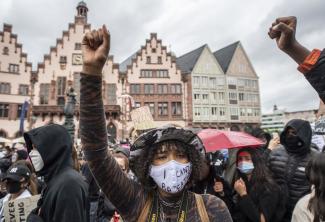Dimensions of racism
Demands for equality and justice

Racism in the USA is a serious issue. The death of George Floyd at the hands – or more precisely under the knee – of the Minneapolis police was yet more proof. A lot must change in the USA.
However, many simple clichés about racism in the USA are too simple. Nuances need to be considered. I think the following points are important:
- Yes, the number of black people killed by the police is disproportionately high, and so is their incarceration rate, but no, police violence and excessive criminal sentencing do not only concern them. White people are affected too, and the poorer they are, the worse the impacts are. Class and race issues tend to overlap.
- It is true that affirmative action has not solved the problems in the USA, but no, it was neither meaningless nor cynical. What it did was to create a prosperous black middle-class, the children of which again benefit from affirmative action. To a considerable extent, racism in the US among poor white people is about not being able to benefit from affirmative action while prosperous children of black dentists or lawyers do benefit.
- Yes, racist attitudes of individual persons matter, but no, that is not what hurts black students most. Structural racism is more important. Black communities all too often are only being served by worse public schools than white neighbourhoods. These schools have fewer teachers per student and less resources in general. On the other hand, if a black child manages to perform well nonetheless, there are opportunities, not least thanks to affirmative action. At the same time, prosperous parents of whatever skin colour often opt for private schools to ensure their children are taught well. To some extent, prosperous black kids then get easier access to top universities thanks to affirmative action. Again, class and race interact in important ways.
It is true that racism persists in awful ways, but no, the general public in the USA is not entirely neglecting the problem. To some extent, there is awareness in Europe too, but we are lagging behind. My impression, moreover, is that the UK and France are ahead of Germany in accepting that there is a problem. In Germany, we like to pretend that we don’t have a problem because our minority communities, apart from the Turkish one, are so small they are almost invisible.
There is racism in other world regions too. I’ve lived in India for a while and founded it striking that racism was actually worse there than in Germany. Upper caste Hindus have irritating patterns of looking down on others – Muslims, Dalits, Adivasis, immigrants. African students told me they felt quite uncomfortable in India. Media reports from China indicate that things may be even worse there, but I have no personal experience.
It is true of course, that black people are underrepresented in US politics, but no, their representation is not irrelevant. Exclusion of specific social groups can actually be worse in Africa itself. At D+C, we once had an intern whose father was from Kenya. She pointed out to me that a Luo – Raila Odinga – could not become president of Kenya. By contrast, another Luo – Barack Obama – became president of the USA.
I think it is absolutely necessary to spell out the harmful legacies of slavery and colonialism, but I also think that we need to consider racism in nuanced and detailed ways. Simply blaming the West is insufficient. In a way that Trump will probably never understand his nation is actually assuming the role of world leadership right now. The protests that erupted there have spread to many other countries – and even forcing the UN to consider racism within its system. It is amazing that a police killing in Minneapolis has sparked protest movements internationally. The British public is now discussing atrocities of the colonial era, and mainstream German media are beginning to look for systemic racism in our country.
To a considerable extent, BLM is thus making the USA a global leader again – though not in a way President Donald Trump or white supremacists would appreciated. One of the most surprising things is that the protest movement has become multiracial. When BLM emerged during the Ferguson protests six years ago, it was a black movement.
On the other hand, had Trump carried out the violent clampdown he was tweeting about, Beijing would have felt free to send the military into Hong Kong. His approach has failed. In a most unusual way, US generals are now openly displaying their disapproval of Trump. One reason is that they do not want racism to undermine the cohesion of the troops. Many soldiers are black (about 17 %), and so are about 8 % of the military leadership.
That does not change anything about racism is awful. That is true of the personal as well as the systemic variety. US society remains unacceptably racist – but as the past two weeks have shown, it is also a leader in challenging racism. Yes, I agree, the progress that has been made in race relations in the USA since the civil-rights movement was slow and not as far-reaching as needed.
Many other countries, however, have made less progress. What other western capital city has seen so many people of colour in top cabinet positions in the past 20 years as Washington did? Of course it makes a difference to have role models like Colin Powell, Condoleeza Rice, Barack Obama, Susan Rice or Loretta Lynch. And it is a very healthy trend that protests in the USA are now resonating all around the world.








